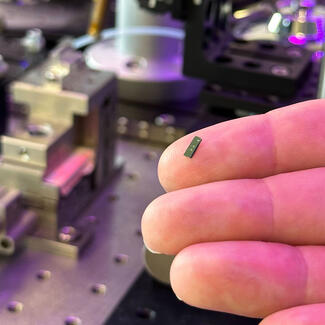
Jelena Vučković's lab is making headlines with their nanoscale laser isolator
Using well-known materials and manufacturing processes, researchers have built an effective, passive, ultrathin laser isolator that opens new research avenues in photonics.
Professor Jelena Vučković's Nanoscale and Quantum Photonics Lab (nqp.stanford.edu) is making headlines with their nanoscale laser isolator. Their paper, “Integrated passive nonlinear optical isolators,” (Nature Photonics) describes their simple and effective chip-scale laser isolator that can be laid down in a layer of semiconductor-based material.
“Every laser needs an isolator to stop back reflections from coming into and destabilizing the laser,” said Alexander White (EE PhD candidate) co-first author of the paper, adding that the device has implications for everyday computing, but could also influence next-generation technologies, like quantum computing.
The nanoscale isolator is promising for several reasons. First, this isolator is “passive.” It requires no external inputs, complicated electronics, or magnetics – technical challenges that have stymied progress in chip-scale lasers to date. These additional mechanisms lead to devices that are too bulky for integrated photonics applications and can cause electrical interference that compromises other components on the chips. Another advantage is that the new isolator is also made from common and well-known semiconductor-based material and can be manufactured using existing semiconductor processing technologies, potentially easing its path to mass production.
The new isolator is shaped like a ring. It is made of silicon nitride, a material based on the most commonly used semiconductor – silicon. The strong primary laser beam enters the ring and the photons begin to spin around the ring in a clockwise direction. At the same time, a back-reflected beam would be sent back into the ring in the opposite direction, spinning in a counterclockwise fashion.
“The laser power that we put in circulates many times and this allows us to build up inside the ring. This increasing power alters the weaker beam, while the stronger one continues unaffected,” explains co-first author Geun Ho Ahn (EE PhD candidate) of the phenomenon that causes the weaker beam to stop resonating. “The reflected light, and only the reflected light, is effectively canceled.”
The primary laser then exits the ring and is “isolated” in the desired direction.
Jelena and team have built a prototype as a proof of concept and were able to couple two ring isolators in a cascade to achieve better performance.
“Next steps include working on isolators for different frequencies of light,” said co-author and EE post-doc Kasper Van Gasse. “As well as tighter integration of components at chip scale to explore other uses of the isolator and improve performance".
Excerpted from Stanford News “New Stanford chip-scale laser isolator could transform photonics."